With Stitchless Garments, Designer Katie Roberts-Wood Links Femininity to Strength
With Stitchless Garments, Designer Katie Roberts-Wood Links Femininity to Strength
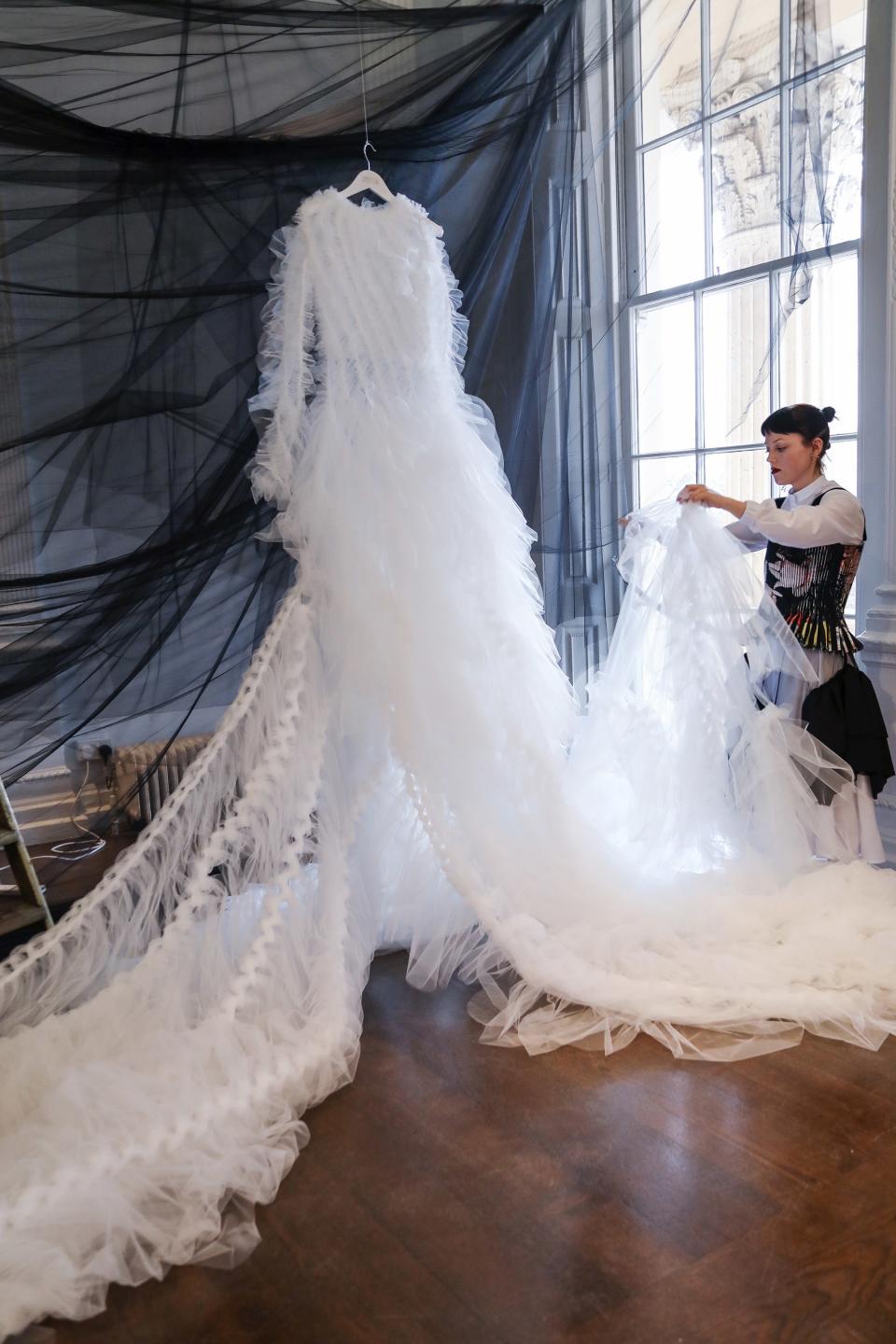
Roberts | Wood Fall 2019
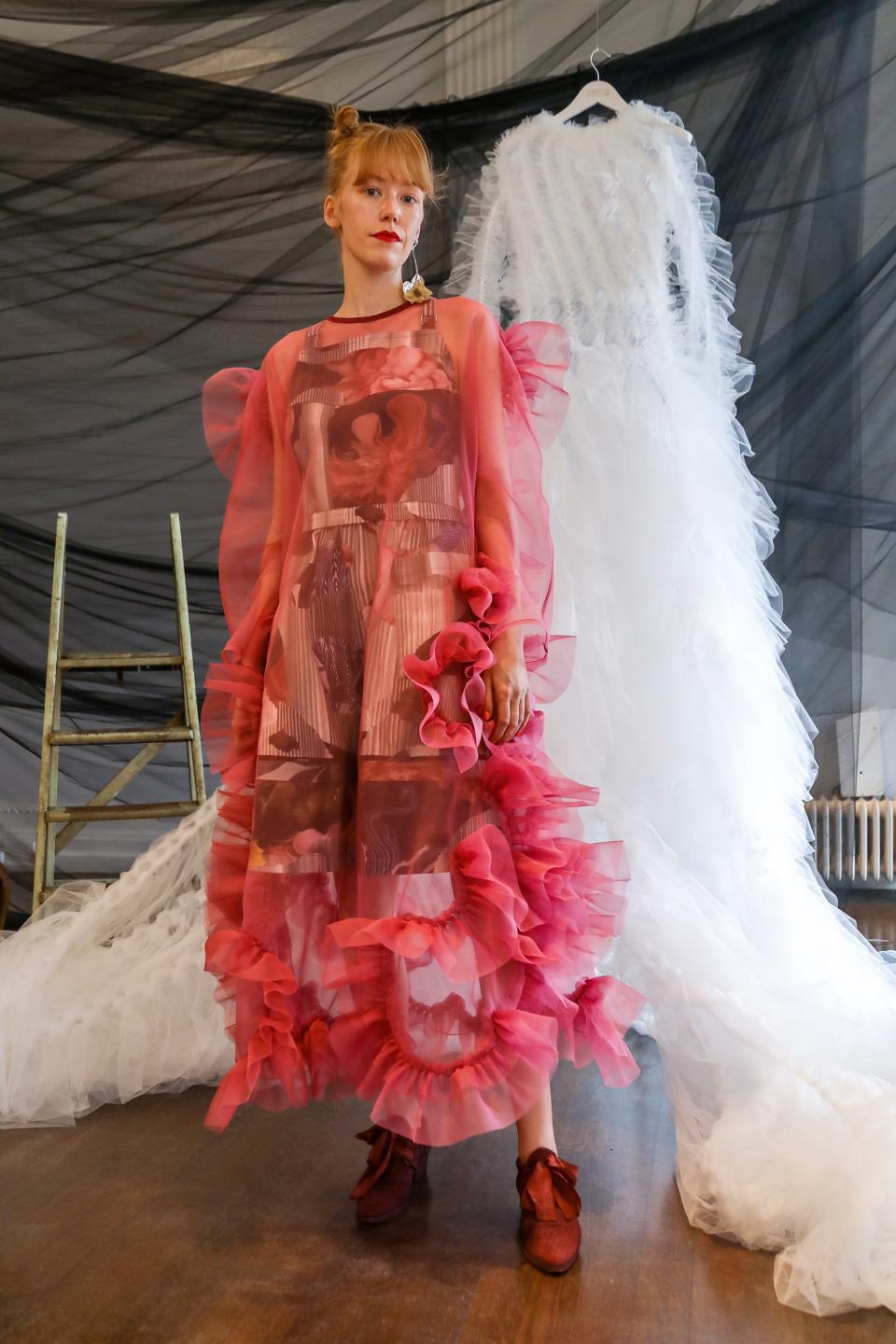
Roberts | Wood Fall 2019
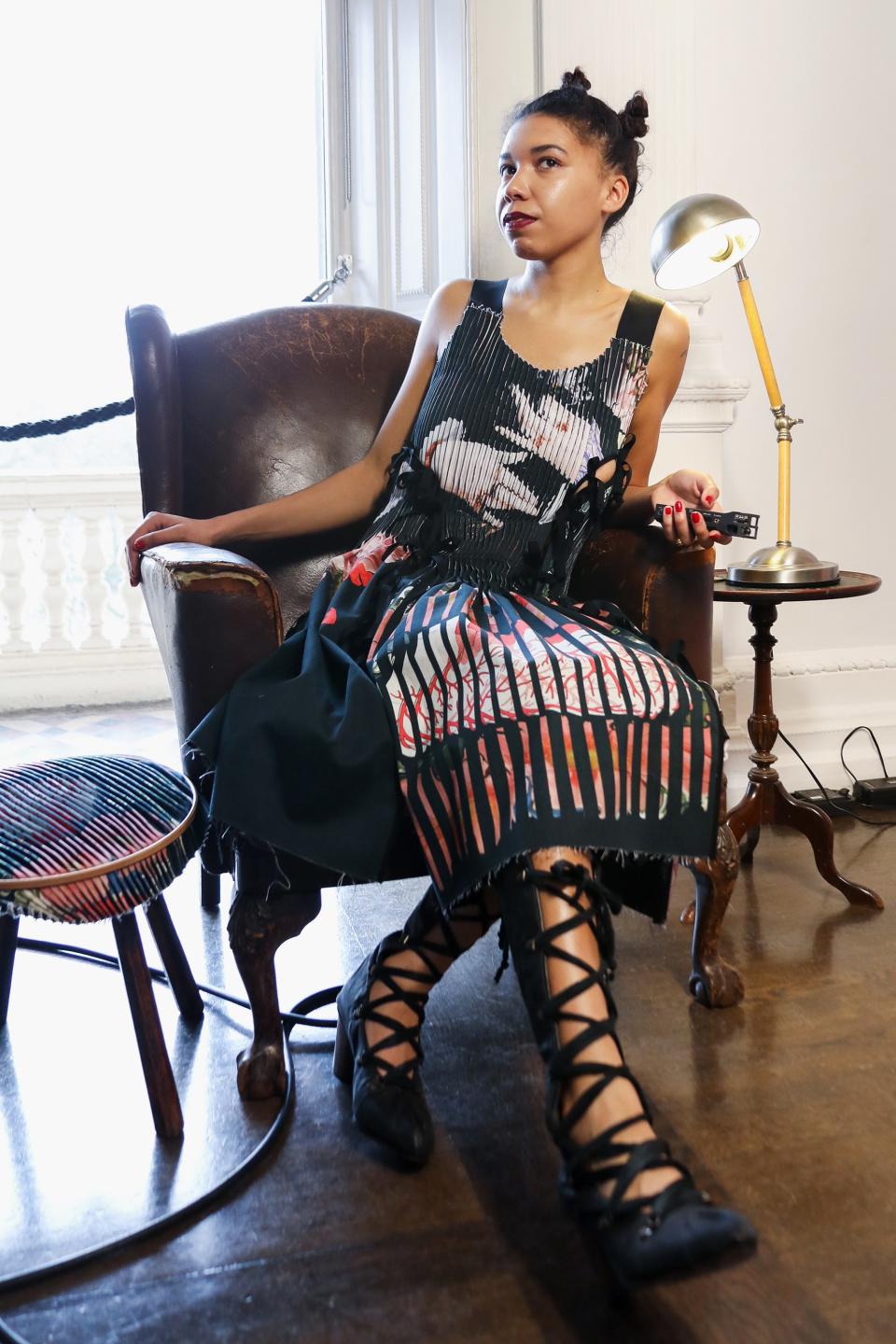
Roberts | Wood Fall 2019
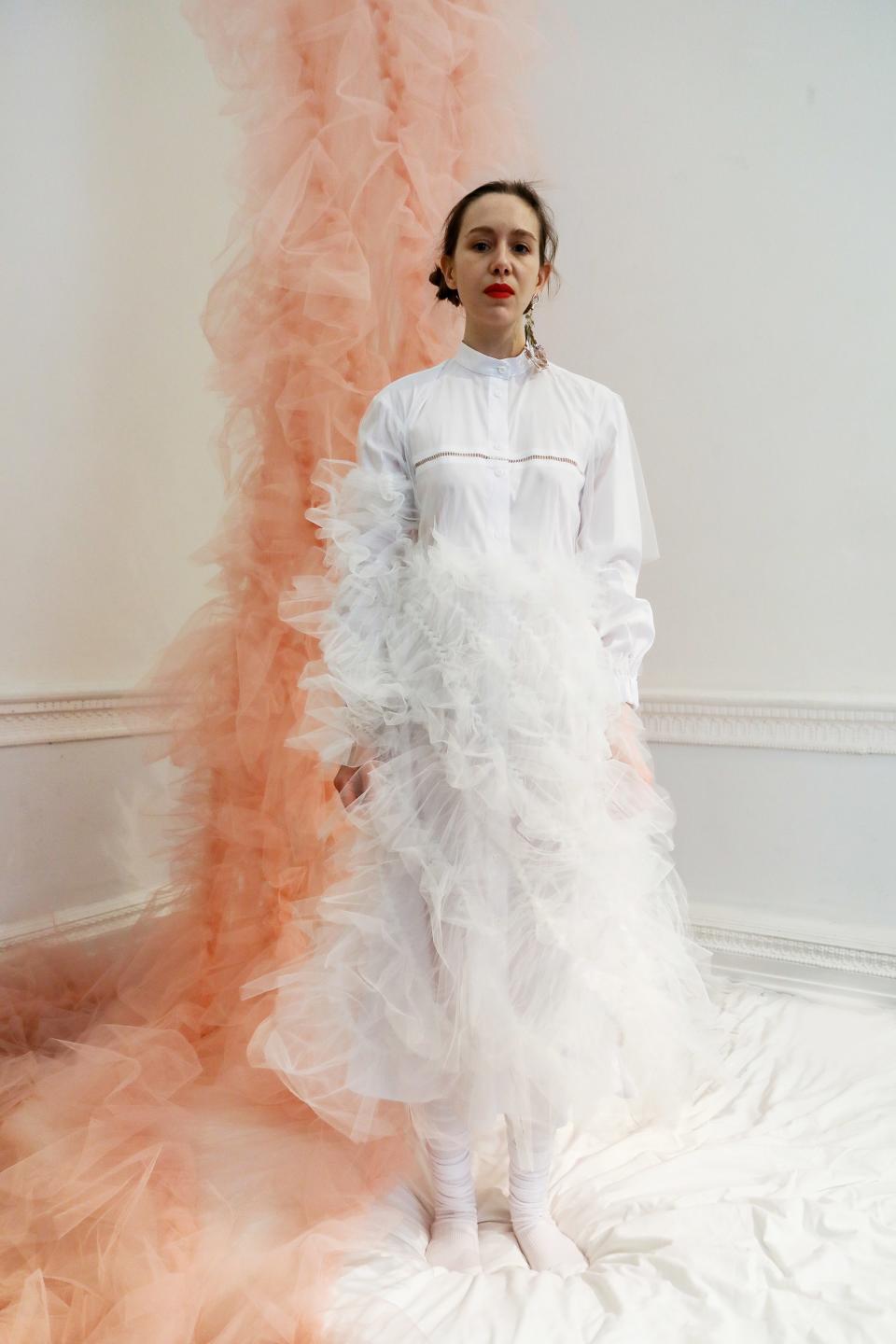
Roberts | Wood Fall 2019
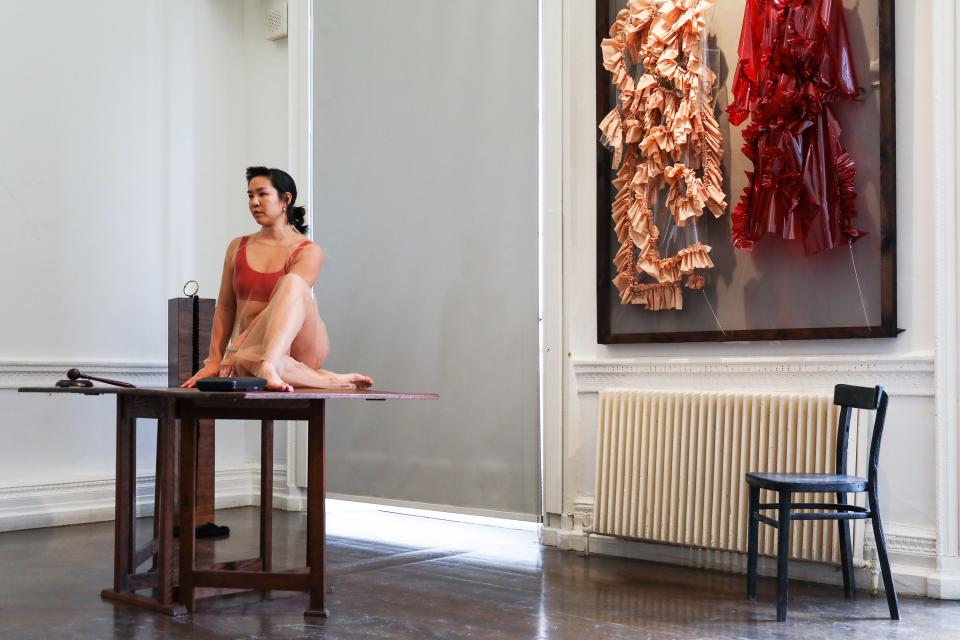
Roberts | Wood Fall 2019
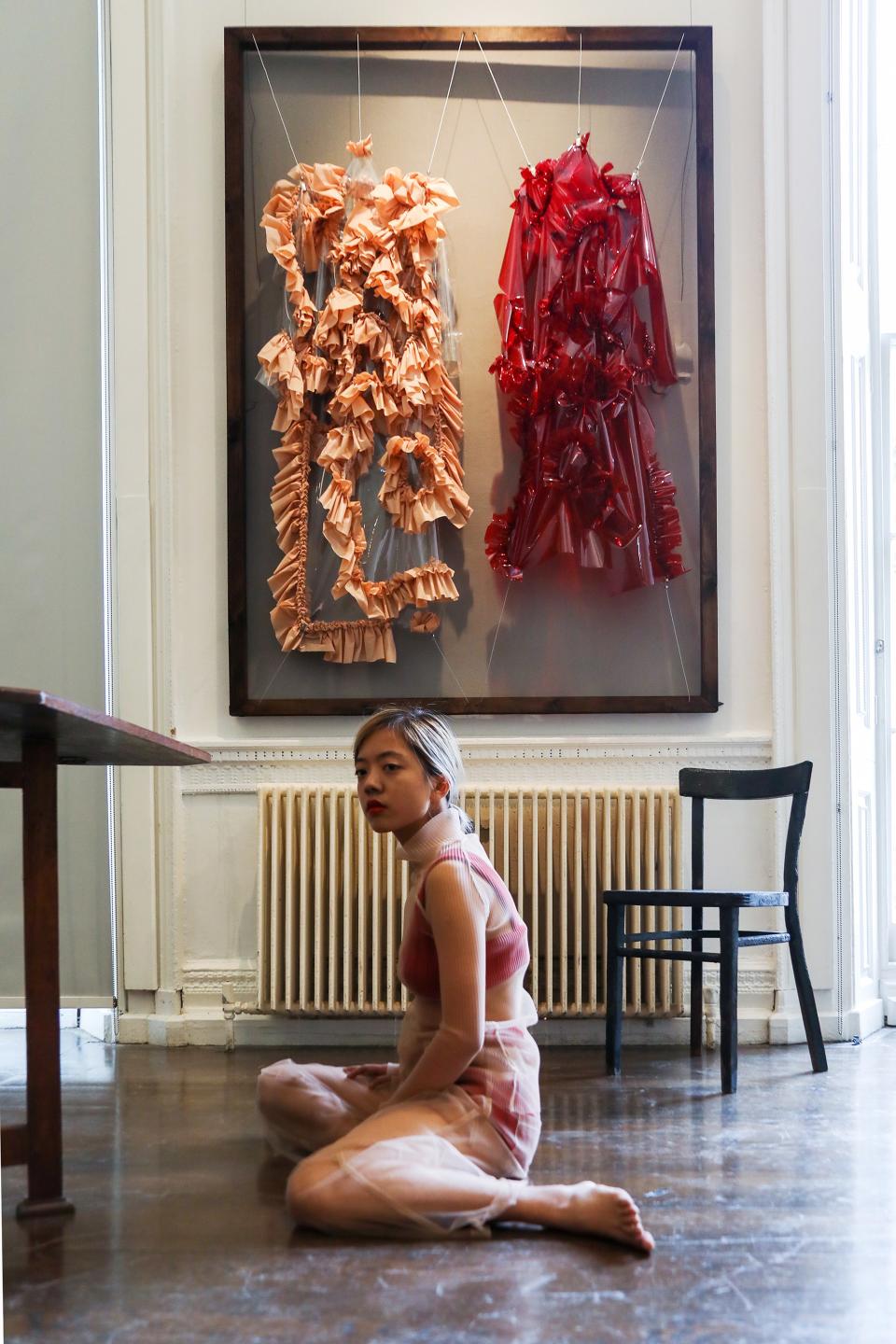
Roberts | Wood Fall 2019
Photo: Jasmine Reif / @judascompanion / Courtesy of Roberts | Wood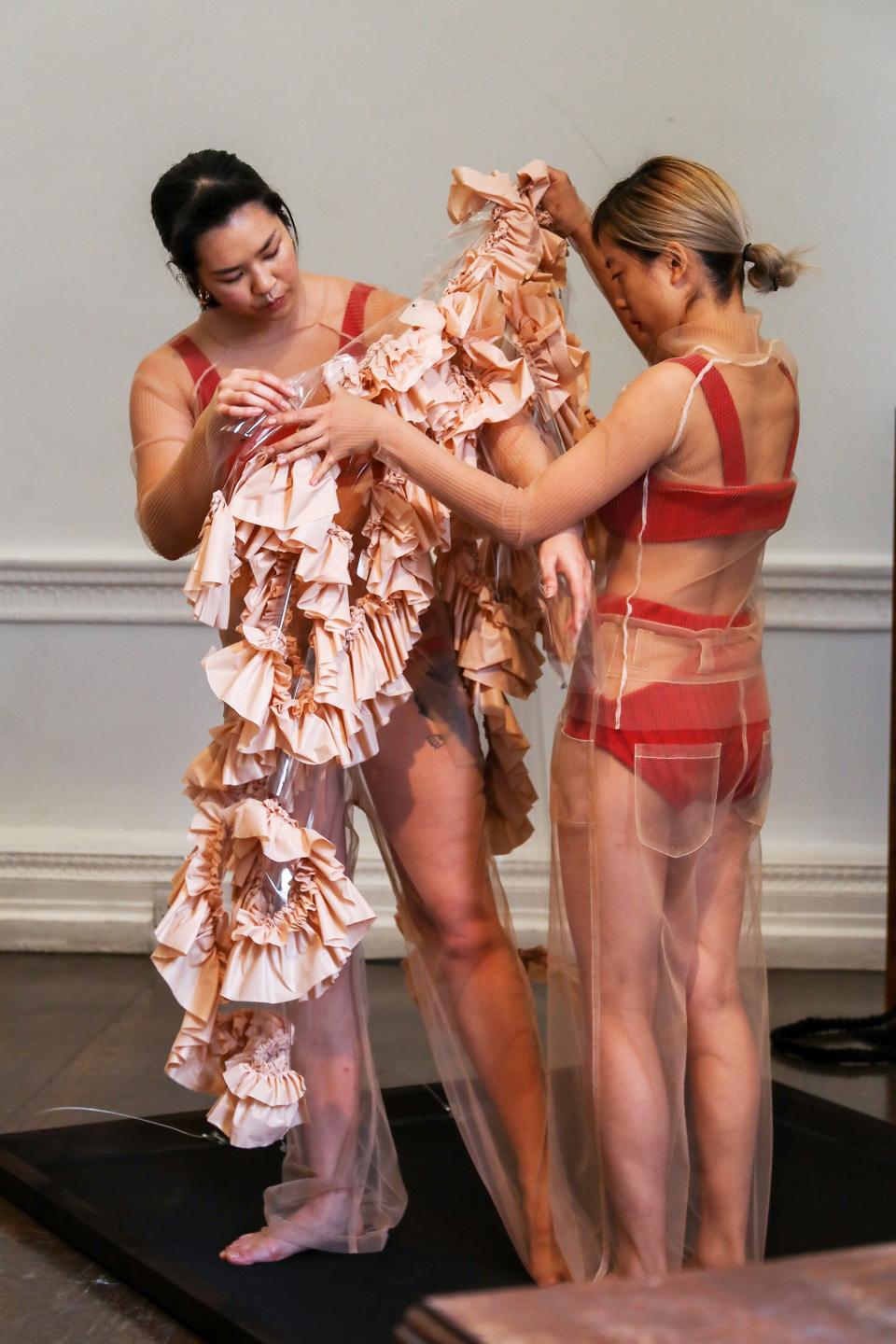
Roberts | Wood Fall 2019
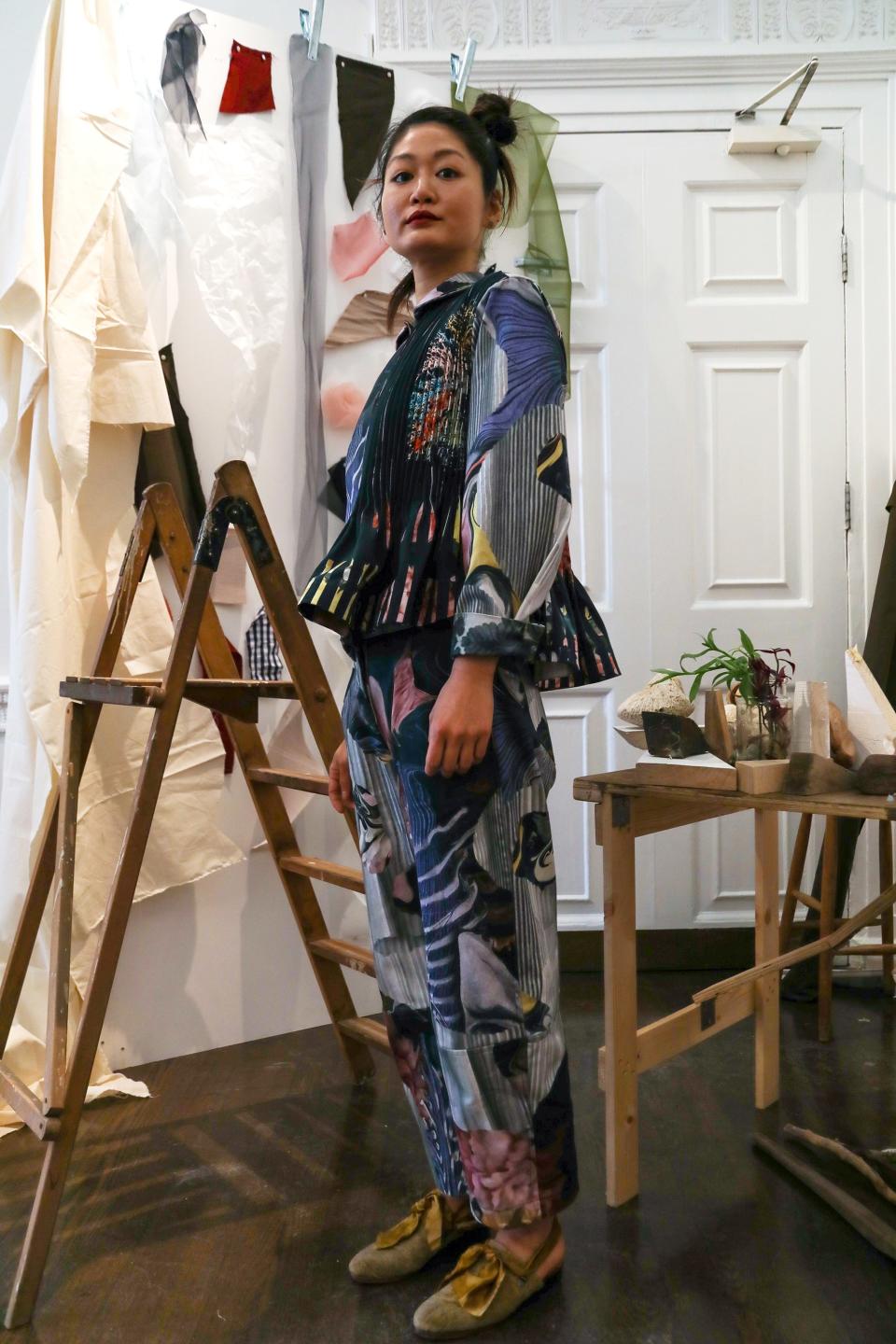
Roberts | Wood Fall 2019
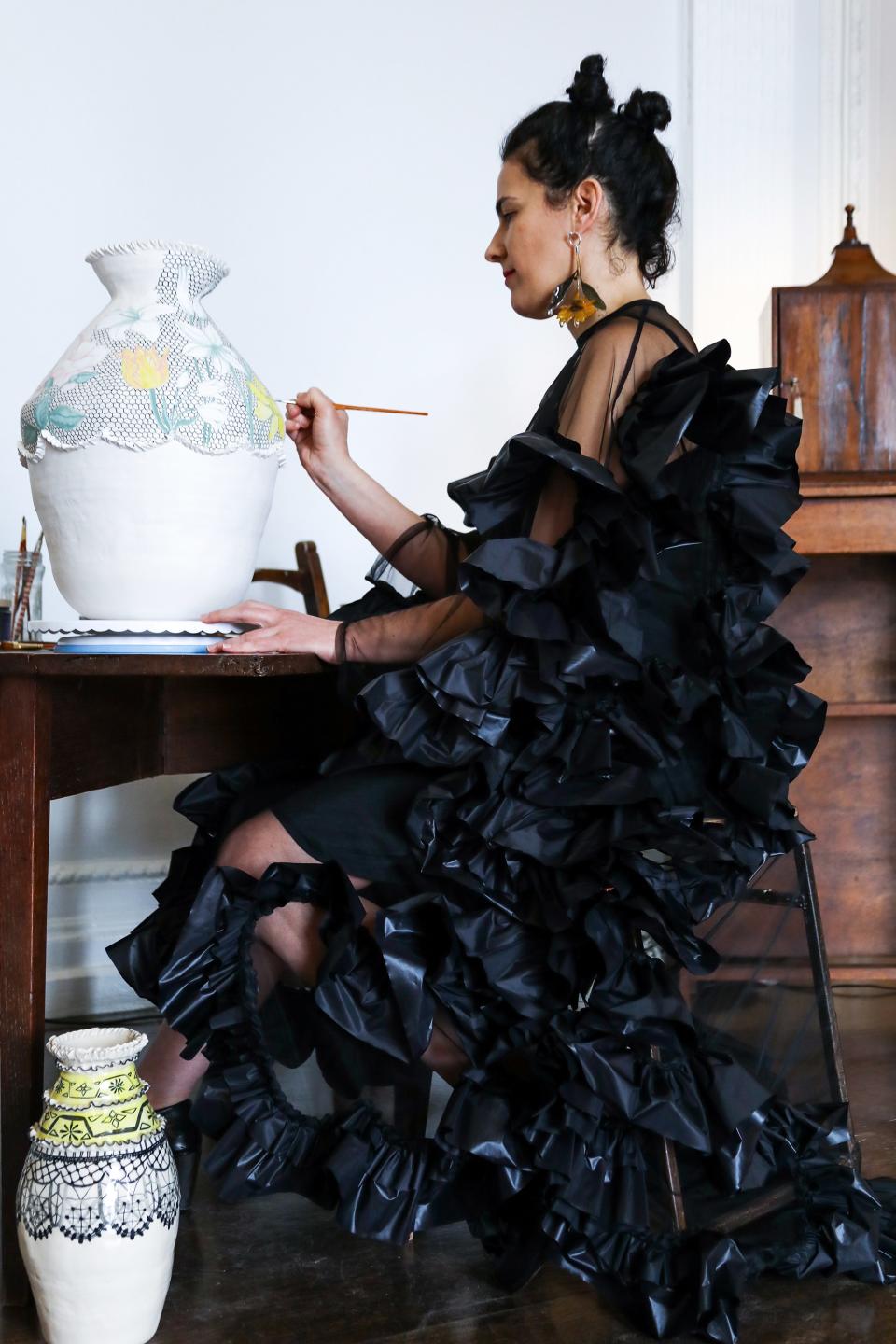
Roberts | Wood Fall 2019
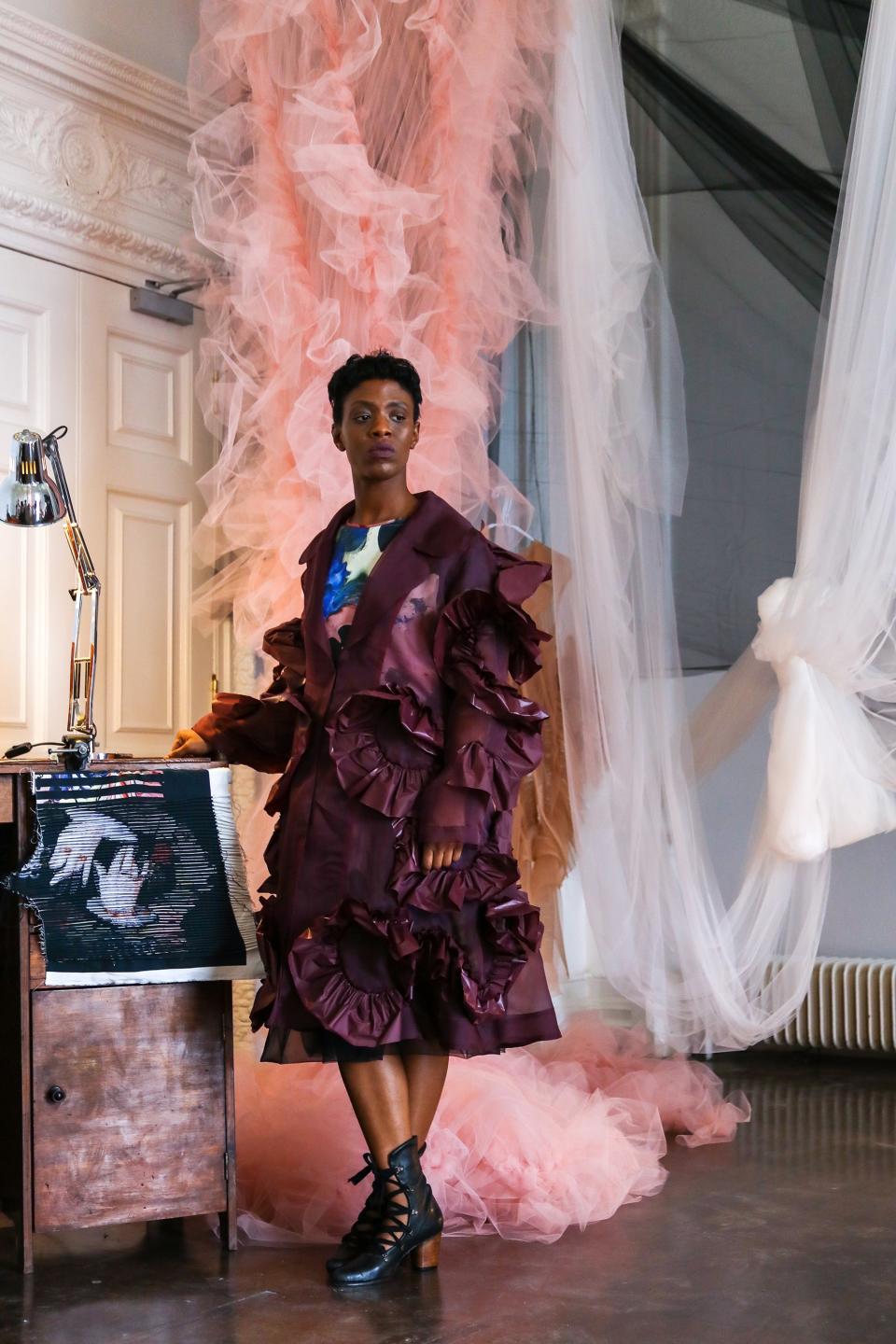
Roberts | Wood Fall 2019
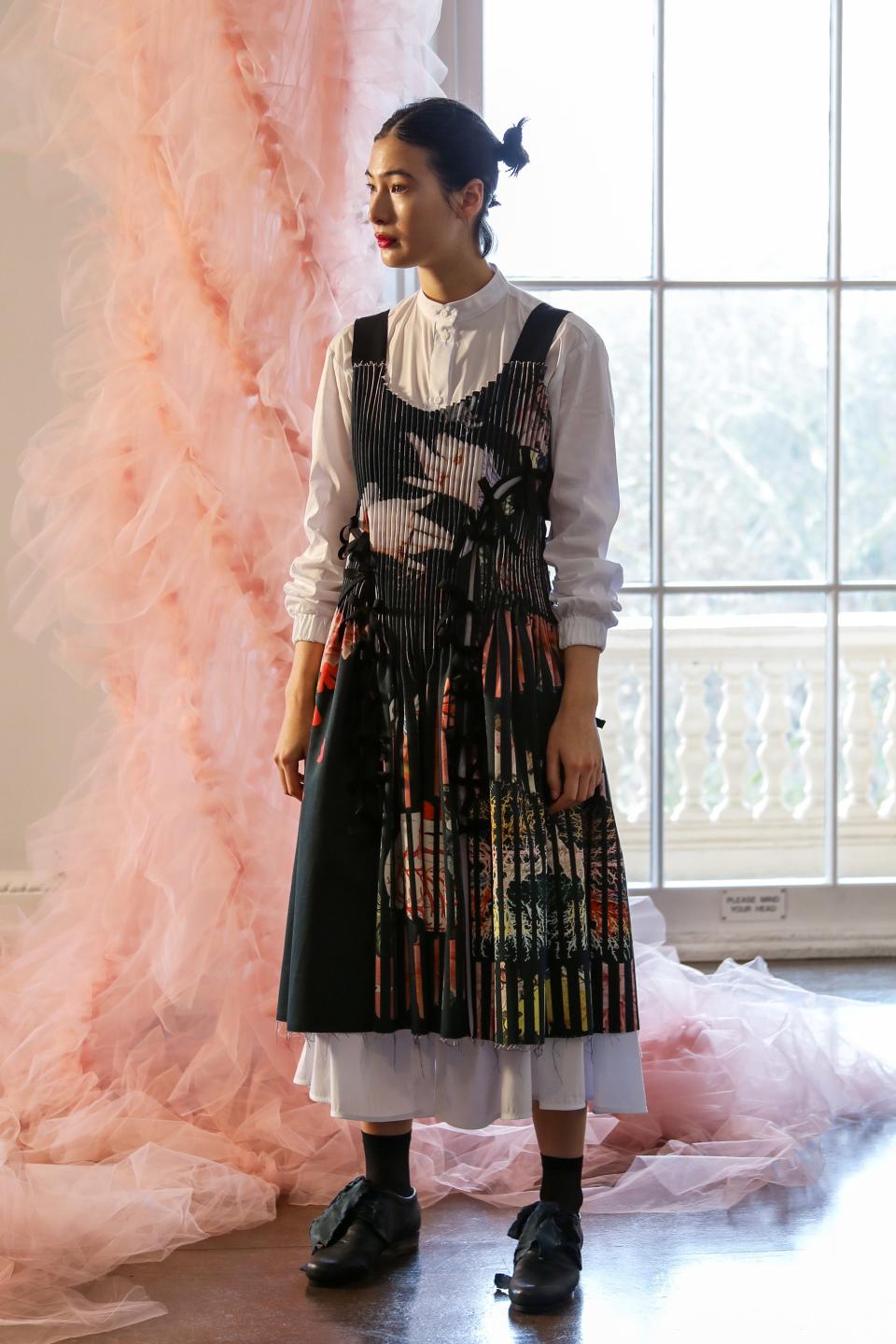
Roberts | Wood Fall 2019
Photo: Jasmine Reif / @judascompanion / Courtesy of Roberts | Wood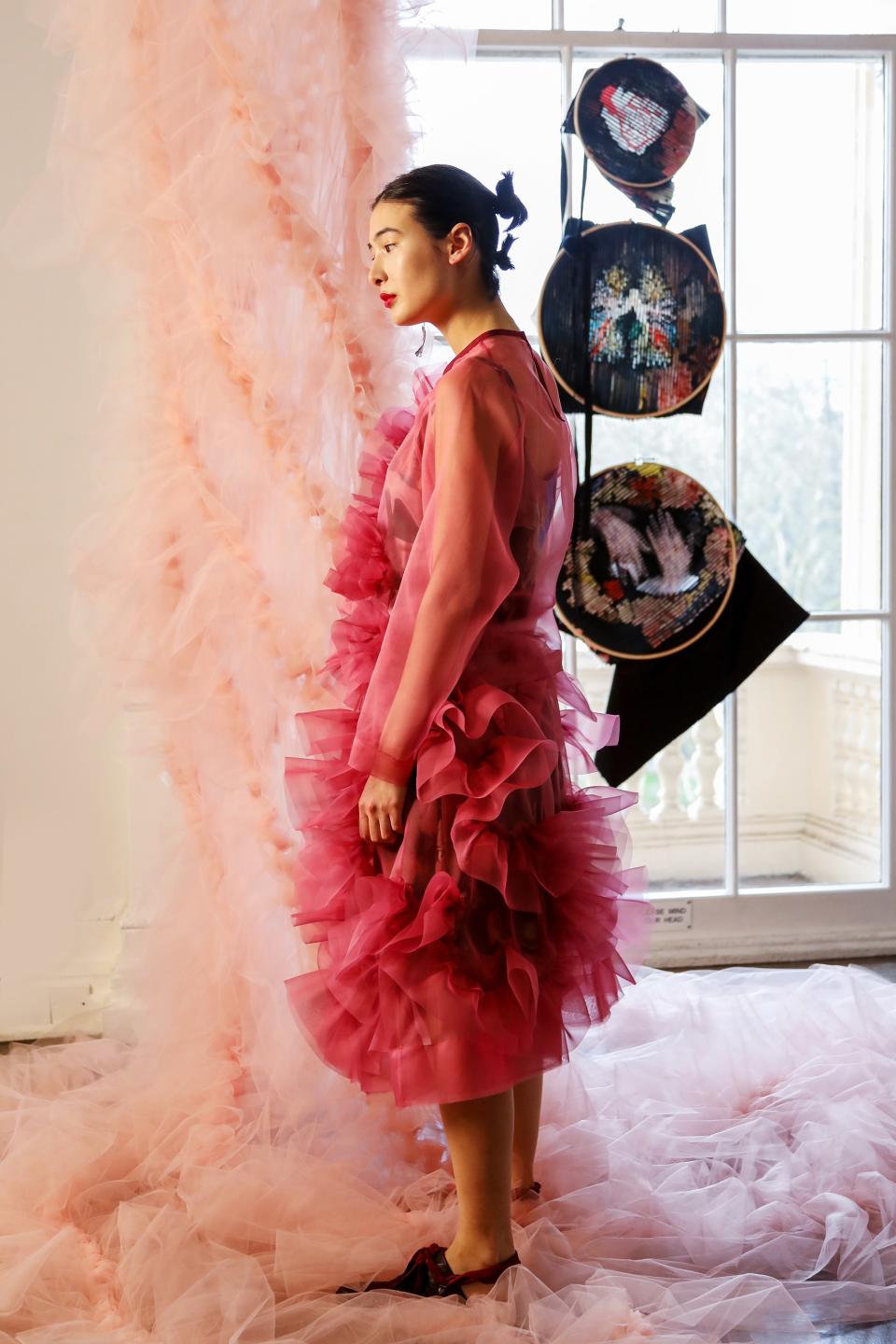
Roberts | Wood Fall 2019
Photo: Jasmine Reif / @judascompanion / Courtesy of Roberts | Wood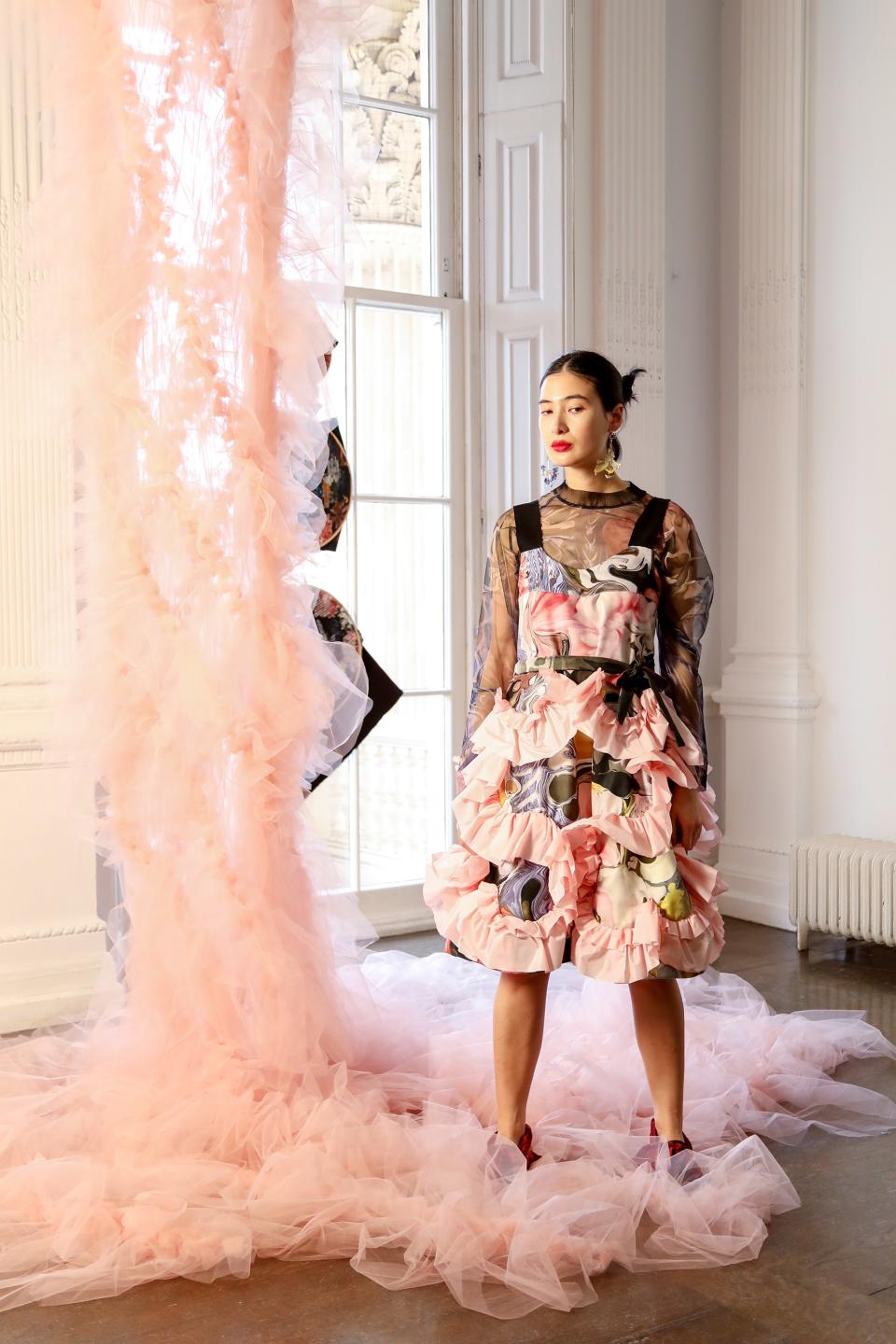
Roberts | Wood Fall 2019
Photo: Jasmine Reif / @judascompanion / Courtesy of Roberts | Wood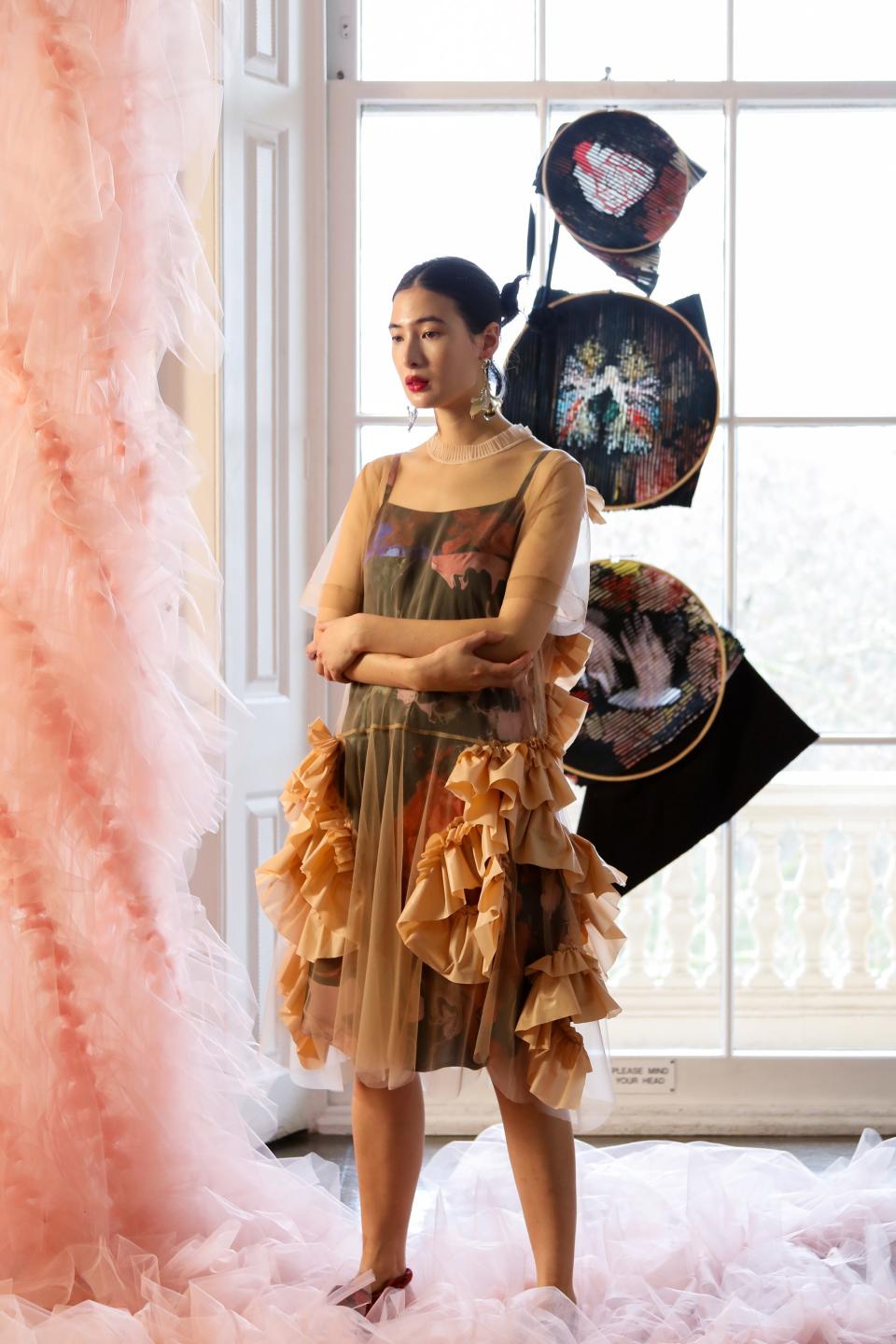
Roberts | Wood Fall 2019
Photo: Jasmine Reif / @judascompanion / Courtesy of Roberts | Wood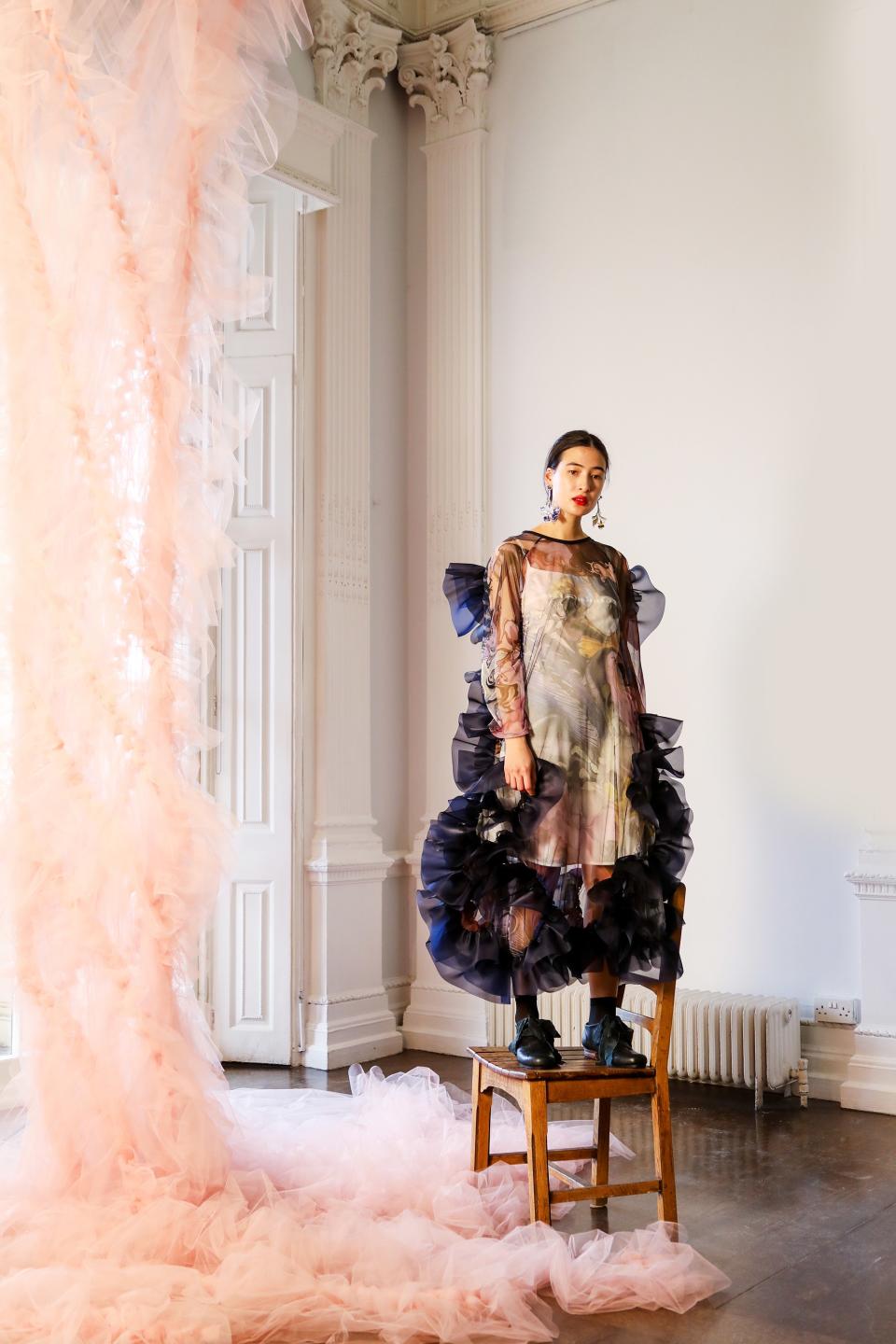
Roberts | Wood Fall 2019
Photo: Jasmine Reif / @judascompanion / Courtesy of Roberts | WoodDesigner Katie Roberts-Wood approaches fashion from a different angle than most—and that’s not because she studied to become a doctor before changing her career course. Roberts-Wood is out to change clothing on a fundamental level: its construction. Led by a single-minded quest for originality, the London-based designer has come “to invent new ways of making [clothing].” Whereas most designers wield a needle and thread, Roberts-Wood has devised a no-stitch way of linking pre-engineered pattern pieces to create three-dimensional garments. Many feature her signature “stitchless ruffles,” which seamlessly convey strength and pure romance.
Currently in residence at the Sarabande Foundation—established by Lee Alexander McQueen to support talent—Roberts-Wood went outside of her comfort zone for her Fall 2019 presentation: She hand-linked an outsize dress in public while seven female creatives simultaneously worked away at their own crafts in their own spaces. These women wore personalized designs from Roberts-Wood, which were tailored to reflect their styles, work, beliefs, and preferences. “It was dreamy to have another designer interpreting me and my work, and that kind of cross-referencing and support and interest is something I really admire,” said Frida Wannerberger, an illustrator who appeared in the presentation.
Creative since childhood, Roberts-Wood has, over time, come to focus her attention on female designers who she says have been “historically, so undervalued.” For Roberts-Wood, discovering their work is pure magic. She is still taken aback by “the skill to create something almost out of thin air, with only your skilled hands and an idea.” There’s legerdemain aplenty in this designer’s work, as well as romance and an unapologetic femininity, which registers as strength to this designer.
Here, Roberts-Wood talks about her inventor’s mindset, frills, and feminism.
Can you talk a bit about your very special approach to making garments?
I’m driven by the urge to create something I find beautiful, but, crucially, I’m obsessed by the idea of making something original. I came to believe that the only way to do this would be to invent new ways of making; to build the garments in unconventional ways that haven’t been done before. It doesn’t satisfy me to take existing ideas and restyle them. I’m just not that kind of designer. To pursue my idea of originality, I started to think as an inventor as well as a designer. I set myself the task for my Royal College of Art Master of Arts collection (2014) to create the whole collection without using any stitching. I designed a construction system wherein I created digitally in 2-D and then laser-cut elements that I would then link together by hand to create unique structural garments, which are formed through repetition of many layers. [That collection] was inspired by waves and the repetitive, synchronized movements of flocks of birds (‘murmurations’). Nature is an important source of inspiration for me. My non-stitched construction idea is both somehow organic—in that the garment is ‘grown’ through the making process—and yet engineered. It was this non-stitched technique that later evolved into the process I use now.
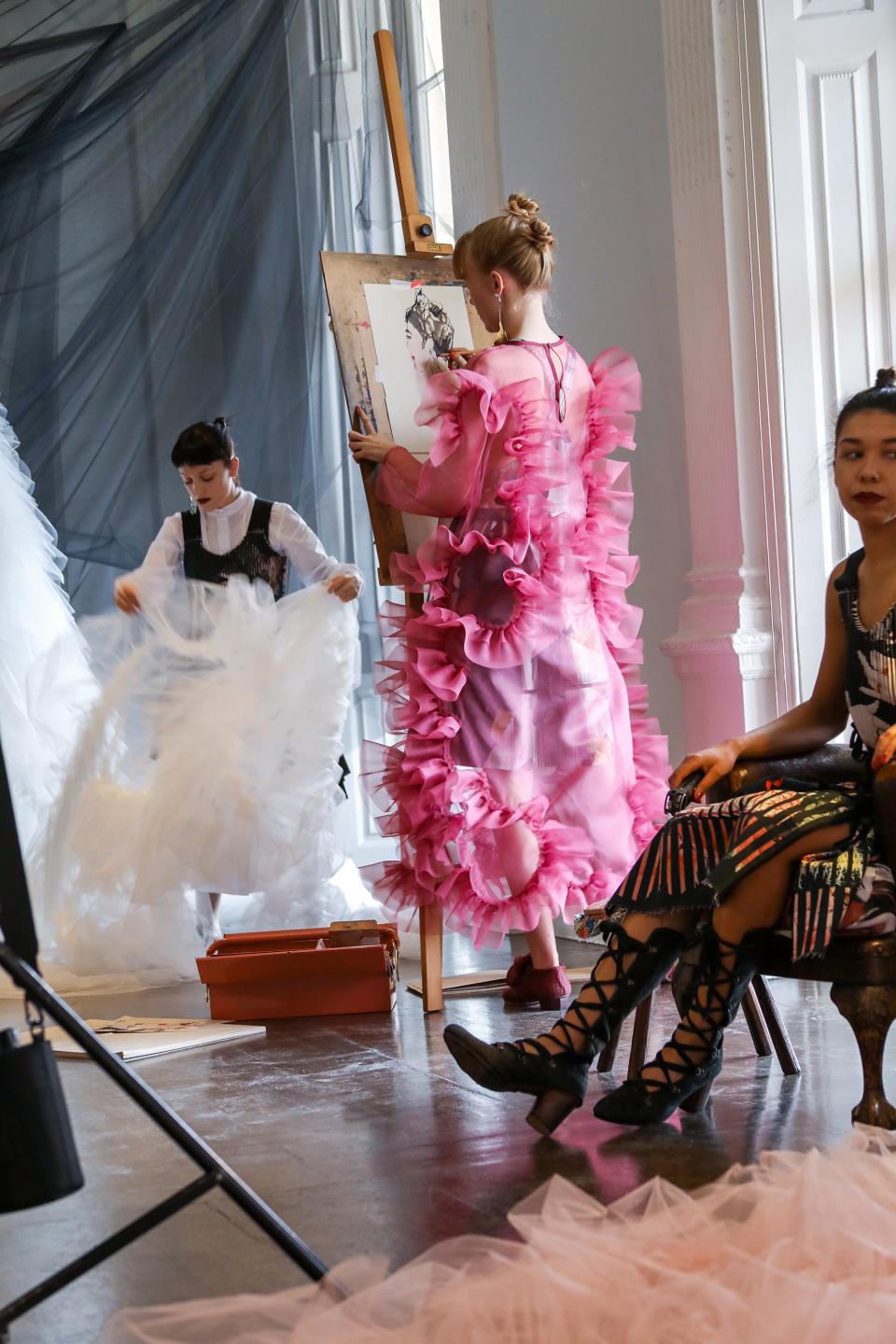
How have you evolved this practice?
I loved the concept of my MA collection—the ideas of minimalism through repetition, new construction methods, and the idea of handwork, but felt the aesthetic was a little too hard for my ideal taste, so I started using my linking technique with softer fabrics and introducing transparency to my work. I wanted the wearer to be able to see the construction methods through the garment, i.e. expose the ‘anatomy’ of the piece without always having to turn it inside out. I wanted the method of making to feel considered and intelligent; a reflection of the women I want to make clothes for. This development turned out to be really effective, and my first collection after graduating—an all-white collection made of only one type of cotton organdy fabric constructed into garments without stitching—was picked up by Dover Street Market for their London, New York, and Tokyo stores. I figured out how to turn the structured layers of my MA collection into soft, non-stitched ruffle layers. I now use a lot of silk organza and netting. I like fabrics that are delicate but also strong, with some structure to sculpt a silhouette with. The ‘linked’ construction of the silk ruffles reminds me a lot of bones, specifically vertebrae—a link back to my love of anatomical structure. I also think of the garments as creatures sometimes, especially suspended, floating, underwater ones.

What is the importance of the no-stitch technique?
Again, I’d say that it’s the drive to present the world with a new idea, not just a repackaging of what they’ve seen hundreds of times. I’m striving to create meaning. Also, to create my own language within the context of fashion. To have a purpose, I need to believe that I’m doing something special, or else what would be the point?
How did you end up in residence at Sarabande?
I had heard about it through some friends who had been in residence there and they recommended we apply for an upcoming space. Again, I didn’t expect I would have a chance at getting a place at this prestigious foundation, but I have never let the slim odds stop me from trying! I’m very ambitious like that, if not always the most confident. I interviewed with Trino Verkade and showed her my work, which I think struck a chord with the originality of the craft and intelligence of my making methods, as well as my creative ambitions. They look for fearlessness in their artists and designers, and I’m very proud that they saw that in me. I feel extremely lucky to be a part of the community here. It’s very interdisciplinary and opens many creative avenues for collaboration and dialogue with other creatives from totally different backgrounds. It’s really influenced my recent choices to show my collection in the way I have: inviting other creatives to join me in my world, wearing my clothes, but doing their thing.

What was the starting point for your Fall 2019 collection?
I always start with techniques and fabrics, then build in the concept in layers of ideas. I developed an advancement of my linking technique that allowed me to create non-stitched three-dimensional spiralling ‘vortex’ shapes. These appear in the dress I created for Frida Wannerberger, which twists around the body, with projections of gossamer ruffles that burst out of the linked sections—this technique also appears in the ‘pink vortex trees,’ which spiral from the ground to the ceiling as part of the set. I made these using just one pattern piece that is cut multiple times, then all linked together to form the vortex structure. Another important starting point was the anatomical prints, which are distorted and integrated into engineered pleated pieces, for example, dresses, jackets, and accessories. I was looking at my father’s Gray’s Anatomy from when he also studied medicine at the same university as me. It was a very poignant moment of self-reflection for me and my journey here so far. Lots of complex emotions.
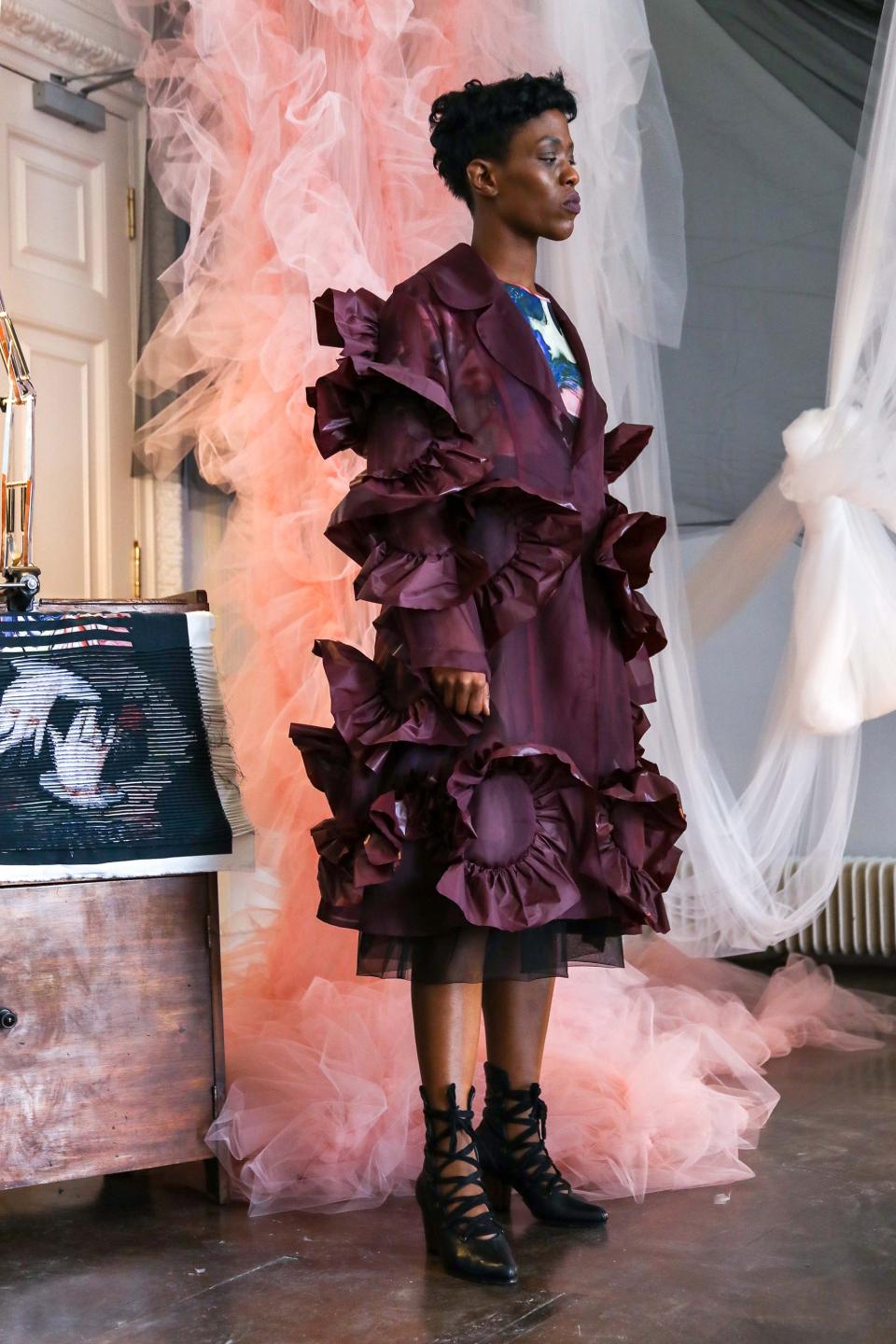
Can you tell us more about the prints?
I manipulated imagery taken from the medical drawings from the textbook, distorting these with 16th-century Dutch flower paintings, which, to me, represent this very beautiful but artificial image. I made engineered prints that, when manipulated into pleats, create a double image, like a lenticular, where you look one direction and see one picture, and another when you look in the other direction. Imagery includes details of heart, lungs, and hands. The hands have become an important symbol to me, of the magic of making and creating. Somehow, also particularly, the idea of women makers, which has been, historically, so undervalued—whereas, conversely, I see it as pure magic—the skill to create something almost out of thin air, with only your skilled hands and an idea. I don’t know how makers came to be so undervalued. I feel like the world is built on those skills.
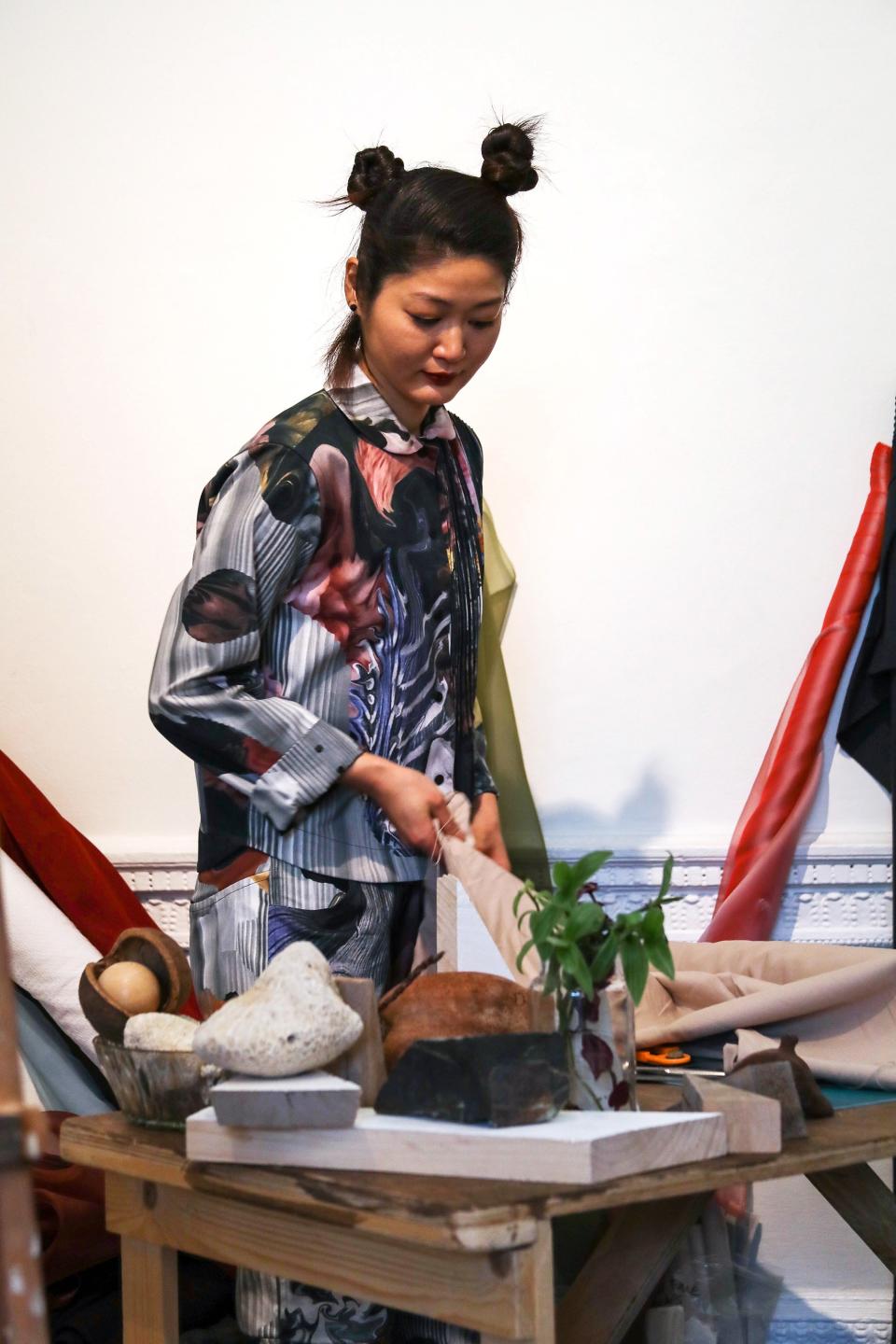
How did you choose to present the collection?
I wanted to show my methods rather than always trying to explain them. It’s hard to describe, but very easy when people see it in front of them, so I took the decision to take part in the presentation myself, doing a live making of a huge hand-linked ‘Vortex’ dress—made live with no stitching. It’s against my nature to want to put myself on show, but this was a rare performance and an idea I really believe in. The process, to me, is a very beautiful and meditative one. It’s really a desire to show that pure love of making things, nothing more complicated than that. I hoped to bring my audience closer to the authenticity of what I’m trying to do. I chose to create the environment of a surreal atelier and fill it with people and things that inspire me. I wanted to collaborate with other intuitive and strong-minded women who do and make things or have some element of their practice that connects with mine.
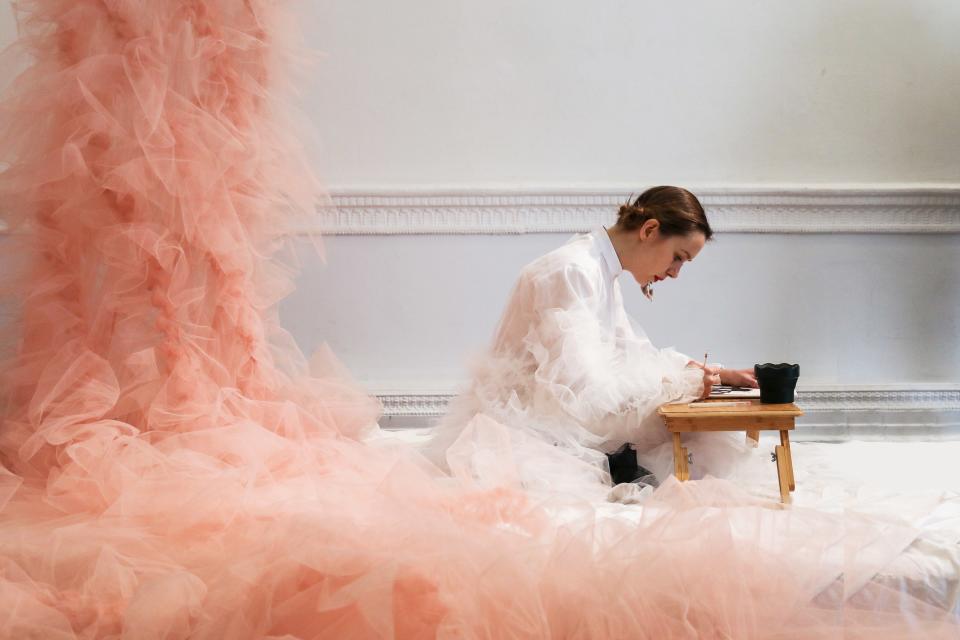
Was your gathering of creative women a feminist statement?
In a way, yes. I have been thinking a lot about what it is to be creative and also the changing landscape of what it is to be a woman today. It’s very personal, and the idea of ‘femininity’ was something about which I conversed with all my collaborators through personal interviews. Some of these conversations were referenced in the soundtrack to the presentation. Femininity is really defined in so many ways by different people. There is such a broad range of interpretations and meanings, none of which I see as right or wrong. Perhaps I was not making a statement, but instead just asking a question. There was no correct answer, I was just curious to hear what they thought and felt about being a woman creative and how they felt about ‘femininity’ and the way they dress and feel they are perceived.
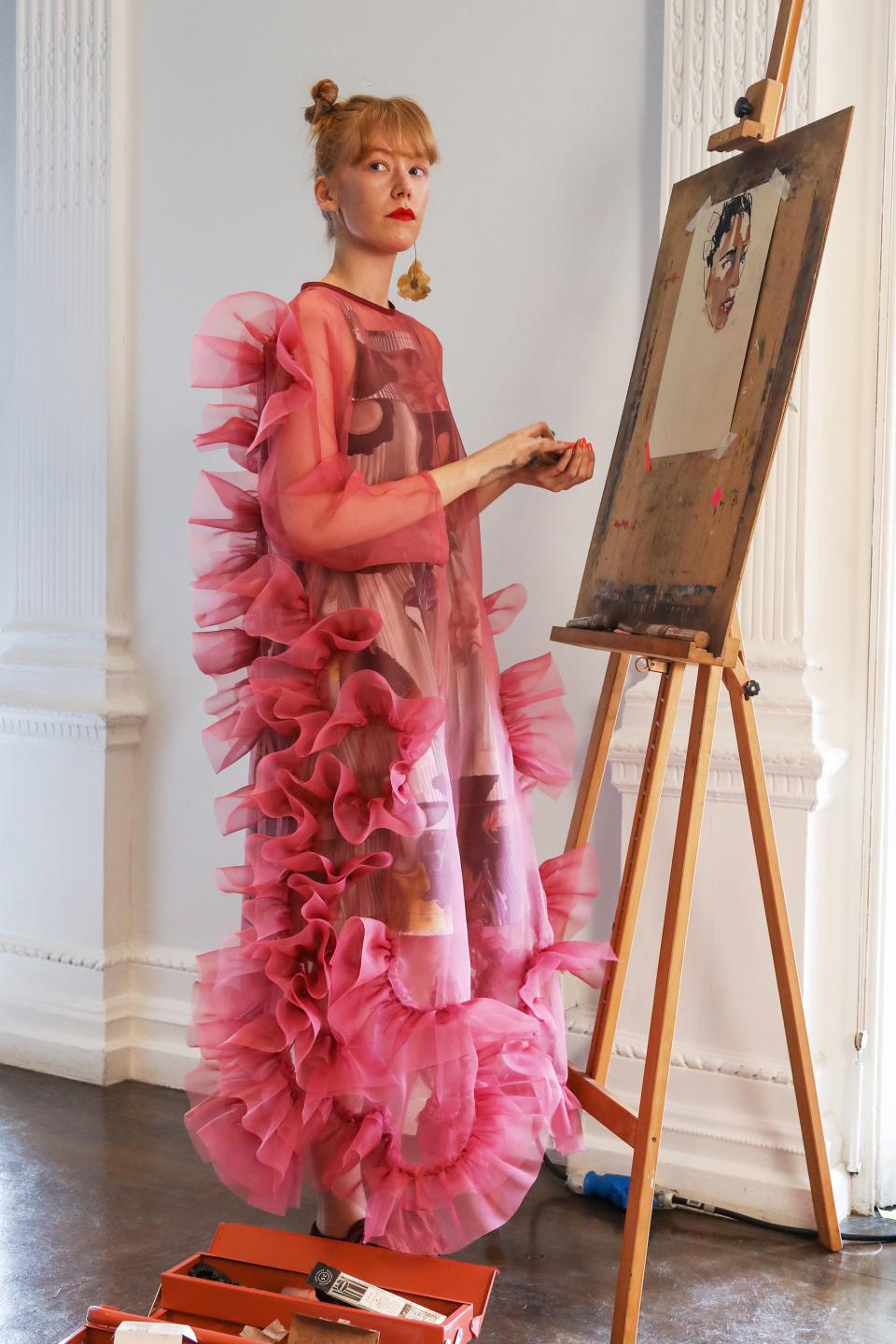
What role does femininity play in your work?
I’m interested in reinterpreting the traditional ‘feminine’ symbols like ruffles, bows, pleats (used consistently though my collections, but always with a twist in the construction, what I see as intelligence), and reframing them in a way that feels strong, soft, and delicate yet structured—all qualities that I find attractive. My personal feelings, as a small, ‘young-looking’ female, is that I feel my femininity can be seen as a weakness to some (still), and I want to empower myself to feel unapologetic about my love of what may be perceived as a ‘traditionally feminine’ aesthetic. Personally, I see it as a very strong thing. I also see the choice to dress more ‘girlish’ or ‘boyish’ as a very important one. I choose to exercise both aesthetics according to how I feel.

What is the import of being a woman designing for other women?
Empathy. I make clothes because I love wearing clothes. I love how they make me feel and transform me and take me somewhere. On the simplest level, I make clothes for people like me. That’s the opposite of what they tell you you should do at fashion school, I know! And by the way, this is not just women, it can be for all genders. I see boys looking amazing in the clothes, too, wearing their ruffled pieces in the most natural, confident way. I love to see anyone getting enjoyment from something I’ve made.
Can you tell me more about your “urge to create magic”?
It’s very hard to describe, but it is the desire to provoke some kind of wonder or curiosity in other people. My favorite reaction is when people tell you they have no idea how you did something. I find a great pleasure in their wondering and wonder.
Why do you think we are seeing a return to swooningly lovely expressions of femininity?
Again, maybe it is to do with the reclaiming of that aesthetic as a strength, not a weakness. To me, it’s empowering. Liking lovely, beautiful things doesn’t mean you are submissive and weak—or shallow, for that matter. To me, it can be the opposite. It’s just a strong form of expression, even confidence. Also, maybe we are feeling the need, more than ever, for romance.

